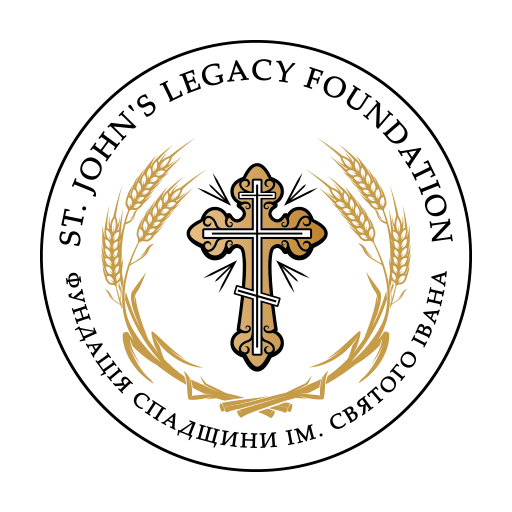St. Paraskewa Ukrainian Orthodox Church – Downing (UOC)
Congregational life was initiated in the community in 1916 (although the church sign dates the founding to 1918, and another source says 1917), when a cemetery was established on six acres of land purchased from Zenovia Kozak at the site of the future church. Work on the sanctuary itself began in 1921, with parishioners donating materials and their volunteer labour.
Completed in 1924, the tripartite sanctuary with two small cupolas over the narthex and sanctuary as well as a central galvanized dome, hosted its first liturgy in June of the same year, with Rev. T. Horbey ostensibly officiating at this joyous occasion. Another memorable event in the early history of the Downing community was the 20 June 1933 visitation by Archbishop Ioan Theodorovich, who formally consecrated St. Paraskeva.
Among the dignitaries who attended episcopal service were Mr. Isidore Goresky, a member of the Alberta legislature, and Michael Luchkowich, a member of federal parliament. A large wooden bell tower was erected in the churchyard in 1948, and a roofed porch was added to the sanctuary in the early 1950s.
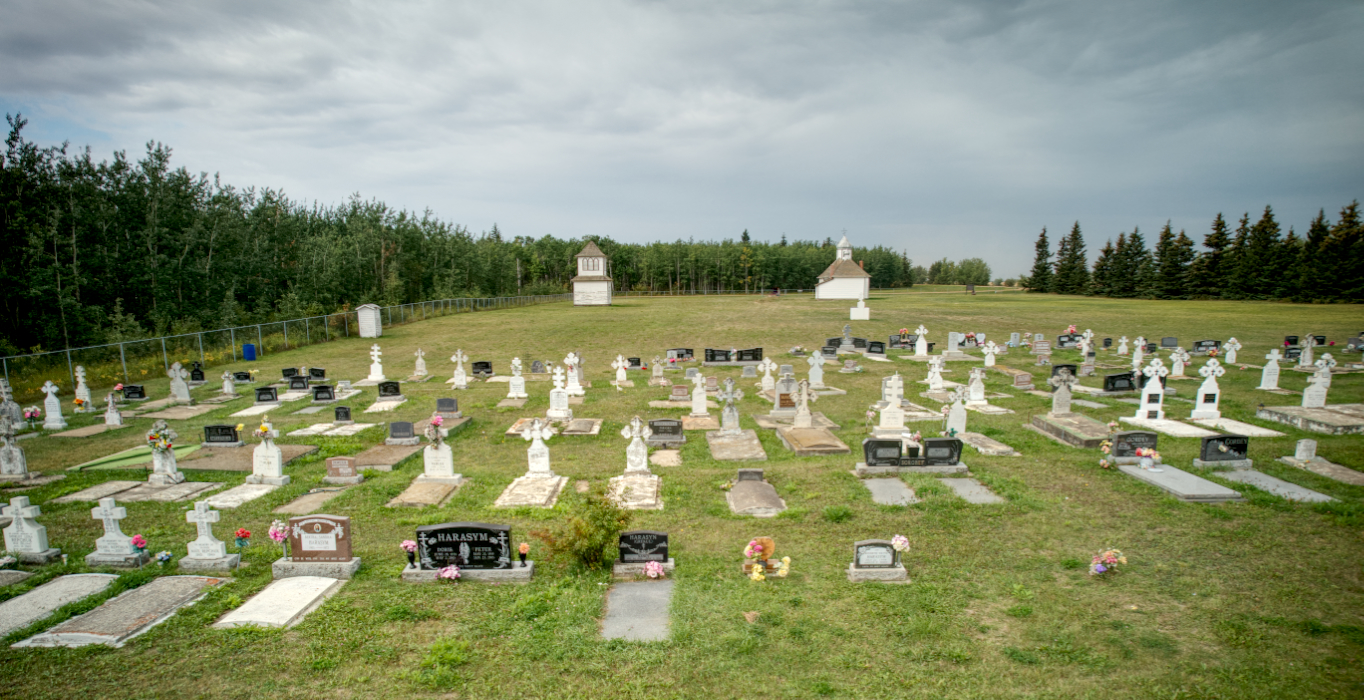
Play Memory Eternal Chant
GPS Co-ordinates: 54.034614, -111.984265
Affiliation: Ukrainian Orthodox Church of Canada
St. Paraskewa Ukrainian Orthodox Church – Downing, AB
St. Demetrius Ukrainian Orthodox Church – Craigend (UOC)
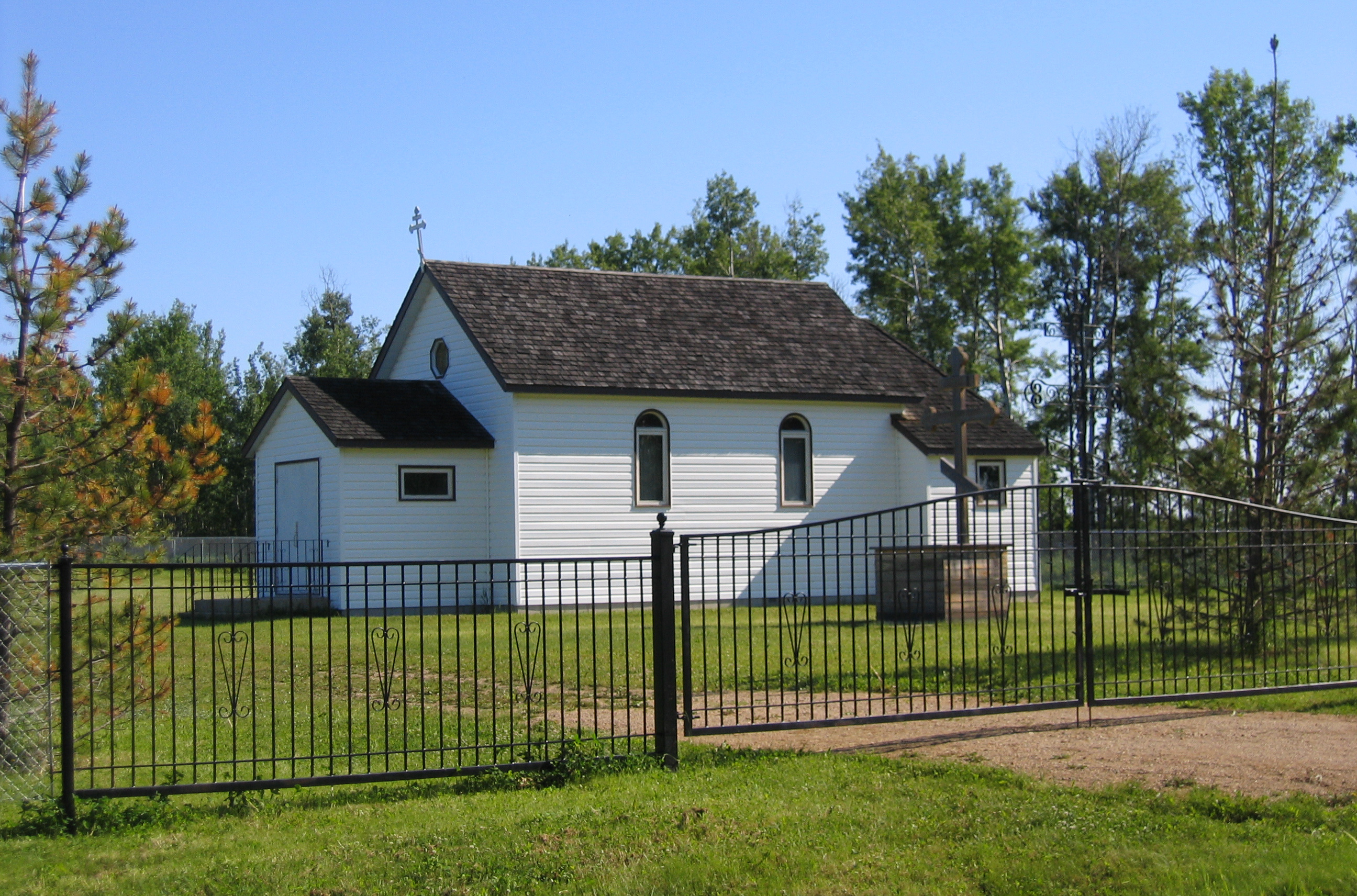
T
he origins of St. Demetrious congregation can be traced back to the early years of the Great Depression. On 11 May 1931, some 35 Ukrainians (originally from Galicia and Bukovyna) who had pioneered the area in 1928 assembled at the home of John and Jennie Palamaruk to discuss the need to establish a cemetery. Every time an Orthodox Ukrainian died in the community it was necessary to obtain permission from local French Catholic residents to use their graveyard for the interment.
At this inaugural meeting, John Palarmaruk Fred Warawa and John Salahub were chosen to obtain land for a cemetery. Some $45 was collected in donations for this purpose. Afterwards, a two-acre property was (adjacent to the French cemetery) was acquired from Narcisse L. Mouille for use as a burial ground. However, in the process of registering the cemetery with the provincial government, the organizers realized that they wanted to have it affiliated with the Ukrainian Greek Orthodox Church of Canada. Thus, they turned to the Consistory to obtain the necessary documentation, that in turn led to their formal establishment as a congregation.
At a gathering held on 15 January 1933, it was decided to form a congregation named the “Ukrainian Greek Orthodox of Craigend, Alberta,” with the original purchasers of the land being designated as the trustees for the cemetery and the congregation. So as to arrange for the legal transfer of the property from the three individual purchasers to the trustees, in April 1933 a letter was written to the Consistory in Winnipeg asking for admission into the Ukrainian Greek Orthodox Church of Canada. Following an exchange of correspondence explaining the requirements for acceptance, a meeting finally took place at the Craigend home of John Salahub on 4 February 1934. The twelve members in attendance voted to accept all of the Statutes of the Ukrainian Greek Orthodox Church of Canada. Eight days later, on 12 February, the new congregation was formally admitted into the UGOC.
Meanwhile, on occasion the Ukrainian Orthodox faithful of Craigend had to turn for pastoral care to other priests who were available to them in their isolated settlement. Thus, on 10 May 1933, a number of families travelled by horse and wagon to the Venice district, southwest of Lac La Biche, to have their children baptized by the nearest cleric, Fr. Ivan Wachiuk of the Russian Orthodox Church. This situation led to some concerns about the threat of Russian influence in the community. In April 1934 this prompted a member to write the Consistory requesting that a priest be sent to Craigend for services several times a year even if the congregation found it hard to pay for them.
It appears that Fr. Ivan Mayba subsequently came to celebrate a Divine Liturgy at Craigend school on the Sunday following Pentecost. Afterwards he blessed the land that had been acquired for the cemetery. He held another service at the same school on 24 February of the following year. It was around this time that supporters of the congregation apparently decided to build a small chapel on their property, so that it could be utilized in the event of a funeral.
However, just as they were about to embark on this project, they determined that it made more sense to direct their energies toward erecting a modest church. Since money were hard to come by in these difficult first years, volunteers cleared the land and prepared the site. Efforts were made to raise funds by means of bazaars, dances, picnics, teas and other activities – the women often playing a critical role in organizing and hosting these events.
In the spring of 1936, the congregation requested a timber permit from the Provincial Department of Lands and Mines. After harvesting 6,000 ft. of wood on crown land at SW 2-65-13 W4, they immediately set about building a church. Volunteers cleared the site and provided most of the labour, assisted by carpenters who were hired with the available finances. By the fall of 1936 the sanctuary was finally ready to blessed. Fr. H. Wasyliw celebrated the first service in the simple country church in early November. It was dedicated in honour of St. Demetrious.
Because of Craigend’s remote location and limited means, it was often difficult for the congregation to bring in clergy to serve in their community. Thus, in 1937, responsibility for the church was passed from Fr. Wasyliw in Smoky Lake, to Fr. Hykawy, who was based in Willingdon. After coming to a financial understanding with the latter, the parish arranged for a Divine Liturgy on 4 July. They sent a member with horses to the train station in Lac La Biche to fetch him in time for the service. When Fr. Hykawy failed to appear as expected, the faithful of St. Demetrious were understandably upset. It was a 16-mile trip into town and some worshippers had even come to Craigend from as far away as Noral, 25 miles distant.
It was later explained that Fr. Hykawy had to attend a clergy conference in Saskatoon around the same time (and that other personal factors might also have been involved). Poor communications obviously played a role in contributing to the misunderstanding. Interestingly, an analogous situation occurred just two years later, when Fr. Sawchenko paid a visit to the parish as the head of the Consistory. When he showed up in Lac La Biche, he discovered that no one had come to meet him. The letter giving the details of his travelling plans was only received following his arrival.
Regardless, after being conveyed by wagon to Craigend, he celebrated a Divine Liturgy at St. Demetrious Church on 2 August, the Feast Day of the Prophet Illia. He then held a second service the following day at the home of Ivan Salahub. In notes that he made during this trip, Fr. Sawchenko reported that he found the congregation in somewhat fractious state. He attributed this to a low level of enlightenment on the part of some its members. He also noted that the church was small and finished only on the exterior, though the property and cemetery were well kept and enclosed with a fence.
The challenges of providing services to Craigend were illustrated by yet another incident that happened in 1940. When Fr. Wasyliw didn’t make it to a liturgy that he had agreed to perform and thereby again disappointed the expectant congregation. This time, it was heavy rains that proved to be the culprit. The roads were still being quite primitive and therefore unreliable in bad weather. Needless to say, the remoteness of Craigend, along with some of the other settlements in the Athabasca and Lac La Biche regions, continued to complicate efforts to deliver regular pastoral care not only during the 1930s, but well into the 1940s.
Nonetheless, the situation of the parish slowly improved. St. Demetrious congregation gradually worked to furnish and adorn their place of worship. They also built a community hall in 1946. In 1950, the parish reported having 12 members. Only two liturgies were celebrated in the community during the course of the year due to a critical shortage of priests.
In 1954 the congregation excitedly prepared for a visitation by Metropolitian Ilarion. He was going to consecrate the church and bless the cemetery at a hierarchical Divine Liturgy to be celebrated on 15 August. Unfortunately, Metropolitan Ilarion fell ill and was unable to attend, but a service was held with Frs. Kowalishen and Hrycyna concelebrating with Fr. Zubrytsky, accompanied by the church choir from Richmond Park. During the course of this year, a total of 11 services were held at Craigend.
Despite many hardships, the members of St. Demetrious persevered in their efforts. In 1959 they enlarged their church with the addition of a sanctuary. A major renovation of the interior took place in 1959, when new flooring and panelling were installed by volunteers. In 1964 Craigend reported having 8 members. They obviously remained committed to maintaining their place of worship despite their small numbers.
In 1986, the church structure and exterior were the primary focus of improvements. This saw a new foundation, new windows, cedar shingling and fresh siding that significantly upgraded the sanctuary’s weatherproofing and appearance. A monumental cross was built beside the church in 1991. The porch was renovated in 1997, and in 1998 a new altar was crafted for St. Demetrious—all of this work being performed by members. Clearly, the self-reliant spirit of the pioneers continues to live on with today’s generation of Craigend church members.
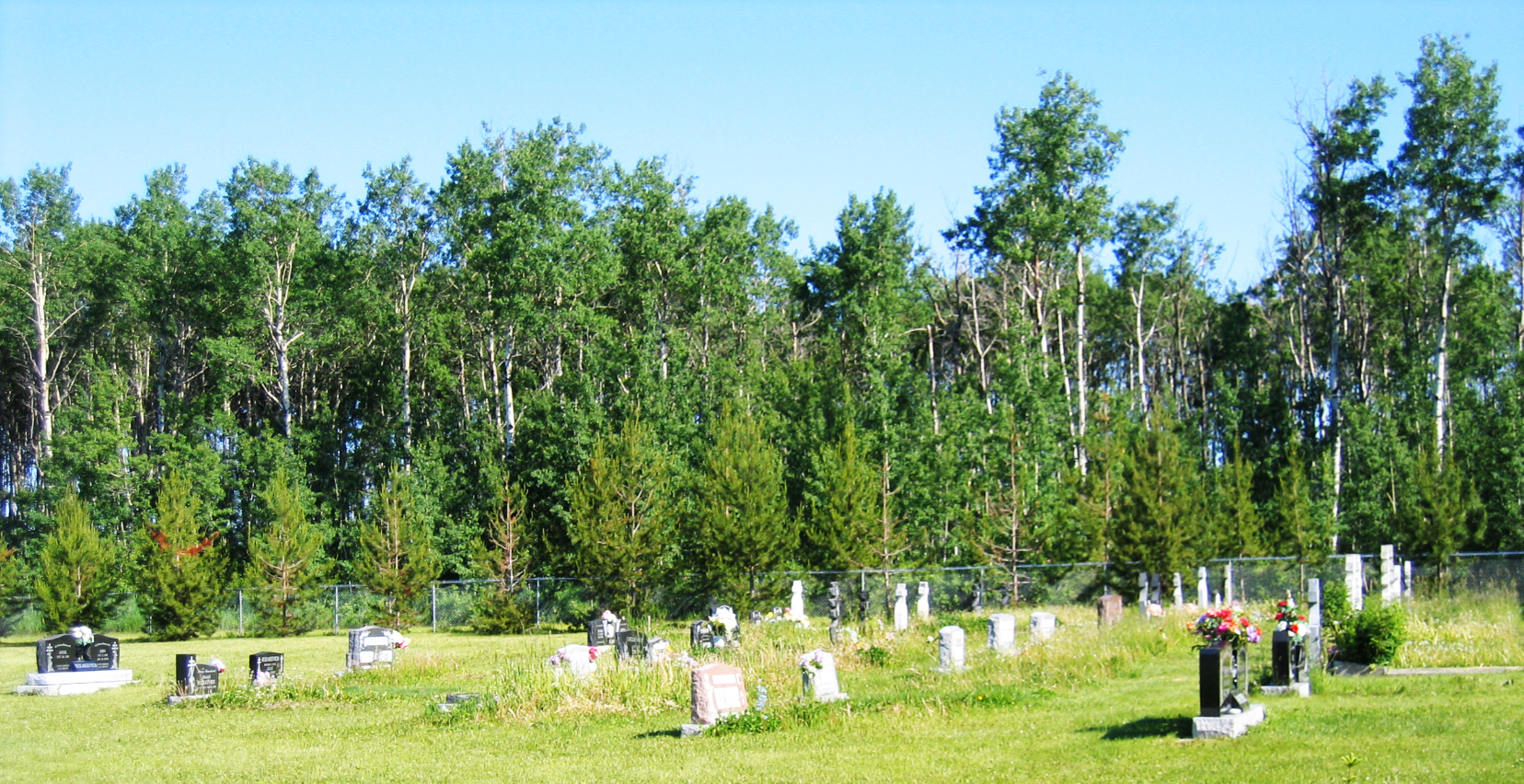

Play Memory Eternal Chant
GPS Co-ordinates: 54.58761, -111.89659
Affiliation: Ukrainian Orthodox Church of Canada
St. Demetrius Ukrainian Orthodox Church – Craigend, AB
Holy Trinity Ukrainian Orthodox Church – Calmar (UOC)
In early 1927, there were meetings amongst several families in order to discuss the essential need for baptism, marriages and funerals in the Ukrainian language. This would involve the traditions that the Ukrainian settlers were accustomed to, and comfortable with. The Ukrainian Greek Orthodox Church of Calmar was officially established on 13 February, 1927, at a meeting in the home of John Fitzowich. Steve Mryglod served as chairman and Walter Shewkewich served as the secretary.
The founding members of the parish were: John Fitzowich, Max Fitzowich, Dan Karashowski, John Kruk, Serguis Lacz, John Manchak, Steve Mryglod, Steve Olekshy, Bill Pawlyk , John Pyrch, Fred Sych, and George Wasuita. The first executive was: Dan Karashowski, president; John Fitzowich, treasurer; Steve Mryglod, secretary.
It was unanimously decided to construct a Temple. Pledges of $5.00 to $10.00 were taken from members; however, John Fitzowich himself contributed $100.00.
The building committee sought to build a Temple in the town, but land prices were beyond the reach of the parishioners. Therefore, Dan Karashowski donated 2 acres of land, and on February 24, 1927, Mr. W W Carrol of Carrol Agencies completed the legal transaction. All the construction tasks were shared out.
At a meeting in May 1927, it was decided to apply to the Consistory (central office) of the Ukrainian Greek Orthodox Church of Canada for membership and for the provision of regular Sunday services. The first service was held in the home of John Fitzowich on June 2, 1927, the Feast of the Ascension of Christ. The priest who served was the Priest Metro Senata. He named the parish “Holy Trinity Church”. He also blessed the cemetery and administered sacraments. Services continued to be provided at the Fitzowich residence until the construction of the building had proceeded far enough to allow services to be offered in that space.
Construction of the Temple began on August 29, 1927, with Peter Turetsky as the hired carpenter. The construction proceeded apace at first. Later in the year, Bishop John Theodorowych and Father Shewchuk visited the community from Winnipeg. However, the cost of construction was great, and the resources were limited. It therefore took until 1936 to complete the construction and to clear any debt. The Cross on this Temple was made by a local blacksmith.
The parish grew in numbers, which produced the awareness that more room was required in the Temple. On October 10, 1958, there was a general meeting which authorized the construction of a new and larger Temple. The old Temple was dismantled, and a new and rather larger structure was constructed on the same site. The Crosses for this Temple were forged by a local blacksmith, as before.
In June 1960, Archimandrite Alexander (Scherban) served the first Divine Liturgy in the new Temple.
Soon afterwards, a bell was purchased from the Leduc Fire Hall and placed on a metal stand.
See HERE for additional information and history of this parish. 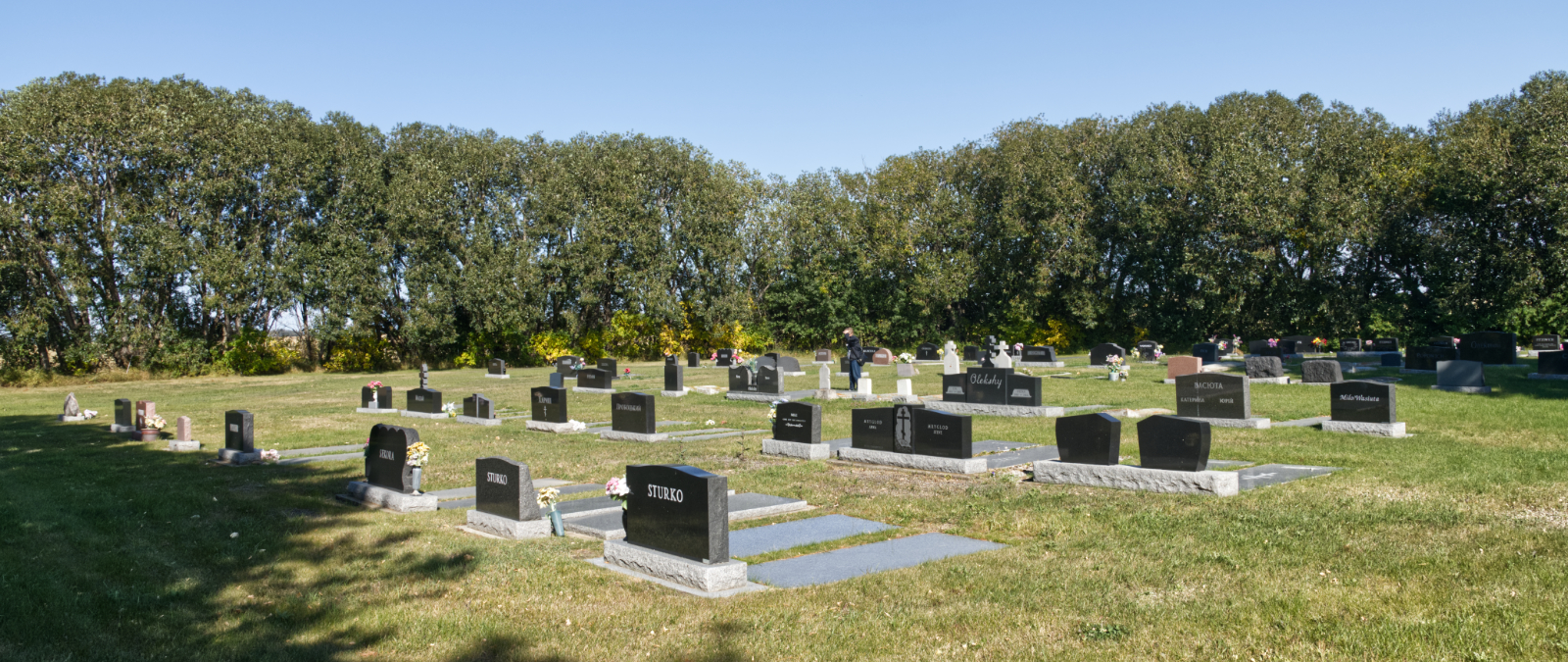
Play Memory Eternal Chant
Visit this Cemetery
GPS Co-ordinates: 53.265485, -113.854082
Affiliation: Ukrainian Orthodox Church of Canada
Holy Trinity Ukrainian Orthodox Church – Calmar, AB
Holy Spirit Ukrainian Orthodox Church – Brinsley (UOC)
S
ettlers of the Brinsley area undertook the organization of an Orthodox congregation shortly after getting established on their homesteads. In 1915 they built a church of rough-hewn logs on the corner of a farm owned by John Hackman (Ivan Hekman), but this structure was destroyed by fire in 1920.
A new place of worship was then erected on the same site in 1924 by volunteer workers, with George Deputat serving as the chief contractor. At the same time, the Brinsley congregation renamed their sanctuary the Ukrainian Orthodox Church of the Holy Ghost, having in the meantime joined the ranks of the fledgling UGOC. However, in 1935, when Fr. Horbay fell ill, the congregation again turned to the Russian Orthodox Church for pastoral care, which was provided by Fr. Ambrose Chrustawka. The Brinsley faithful subsequently returned to the Ukrainian Orthodox fold when Fr. Chrustawka joined the UGOC in 1941.
A tripartite structure crowned by a medium-sized central dome on a large octagonal base, the Brinsley church also has smaller domes over the narthex and sanctuary. A clapboard belltower is situated northwest of the church. In 2008 the belltower contained 2 banners with Romanian inscriptions, whose icons were unsigned but appear to have been painted by Peter Lipinski. Inside the church there in 2014 there was a signed icon by Lipinski dated 1929. In 2008 the belltower’s windows were broken, exposing the interior and its contents to the elements, but now seem to have been fixed.
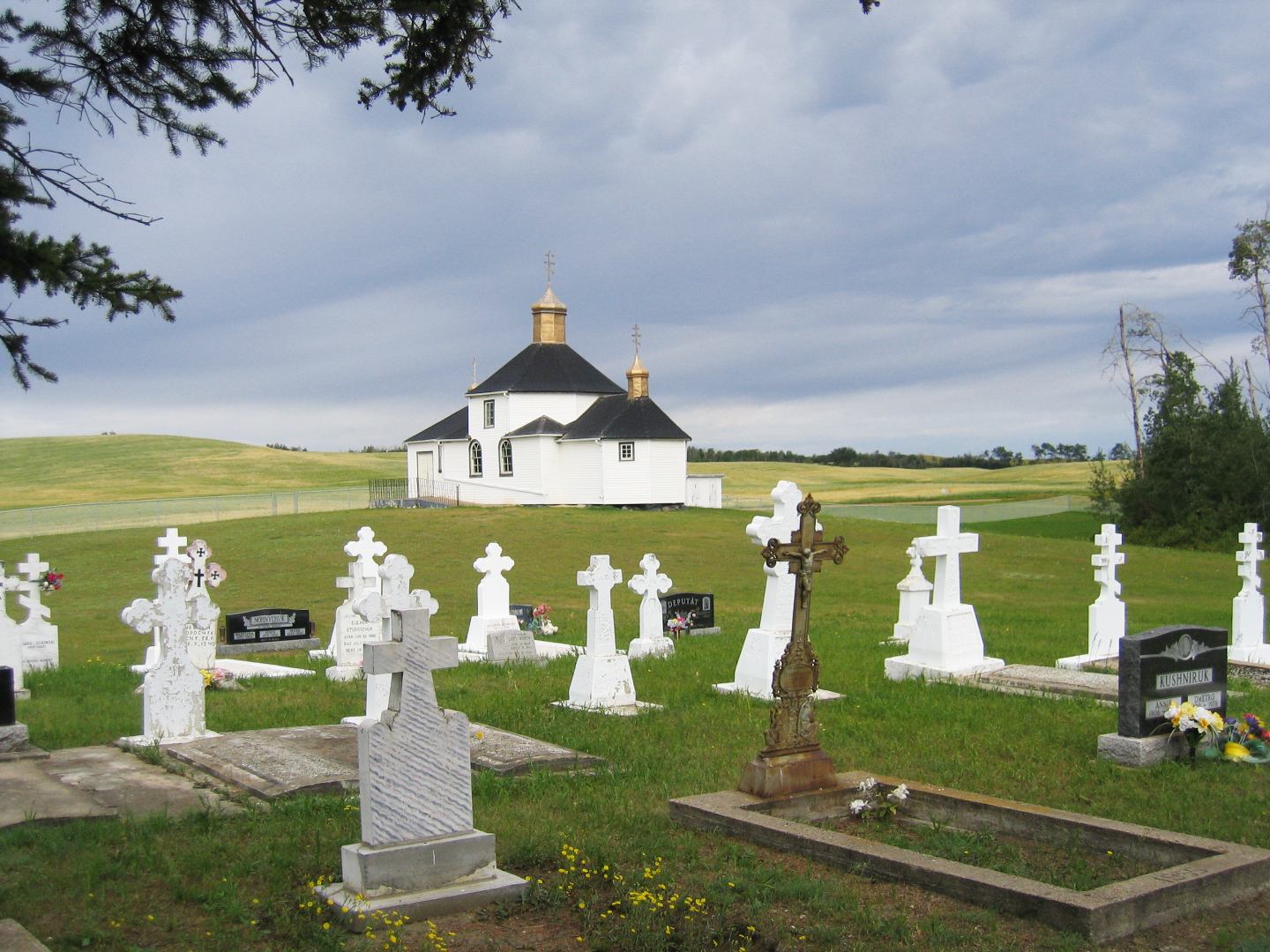
Play Memory Eternal Chant
 Visit this Cemetery
Visit this Cemetery
GPS Co-ordinates: 53.890256,-111.786451
Affiliation: Ukrainian Orthodox Church of Canada
Holy Spirit Ukrainian Orthodox Church – Brinsley, AB
Holy Cross Ukrainian Orthodox Church – Boyne Lake (UOC)
This congregation was inaugurated during the tenure of Fr. Ivan Mayba in Smoky Lake, and subsequently remained part of the Smoky Lake Parish District. According to a letter sent to Consistory on 23 November 1933, by this time an initiative group of local residents was in the process of purchasing a four-acre parcel of land for a church and cemetery from the Great West Life Company in the Boyne Lake district. However, for the land ownership to be transferred it was necessary for the new congregation to be legally registered with a church. Consequently, a formal founding meeting of the Boyne Lake faithful was then held at the nearby Conrad School on 23 December 1933, when an application for incorporation as the Congregation of the Holy Cross was submitted to the UGOC in Winnipeg.
Approved on February 3, 1934, the land acquisition was then finalized a short while later. In June the Consistory was informed that the property had already been fenced in and had a cross placed on it, which it was hoped to have blessed that fall. At this time, it was indicated that plans were being made to begin assembling materials for the construction of a sanctuary in the coming winter. The Consistory was also informed that the new congregation was comprised of 20 members, some of whom were former Greek Catholics.
A modest rectangular church, 20’ by 24’ in size, was subsequently erected at Boyne Lake, with two small domes adorning towers flanking the entryway. Unfortunately, little information is available about the congregation’s existence in the latter years of the Depression and the 1940s. In 1951, five liturgies were reported to have been celebrated at the church, when the congregation consisted of just five members. Five years later the paid membership had grown to eleven families, and six Divine Liturgies were celebrated in the sanctuary over the course of the year, a figure that remained fairly constant in subsequent years. In 1958, the financially struggling congregation informed the Consistory that it could not afford to contribute its allocation to the UGOC budget and expressed concerns that it might fall apart. In 1960, just three Liturgies took place in the church, though membership was said to number 16 families.
In the mid-1960s it seems that the congregation decided to adopt Sts. Peter and Paul as its patrons. However, it subsequently reverted back to its original feast day and name, the Elevation (Vozvyzhennia) of the Holy Cross.
In July 1980, on the occasion of Alberta’s 75th anniversary, a cairn was erected on the church property with a plaque dedicated to the founding members of the church. By the first half of the 1990s, the church was being supported by little more than a handful of families, who nevertheless continue to lovingly maintain and worship in their sanctuary.
There is a hall behind the church, as well as metal bell tower.
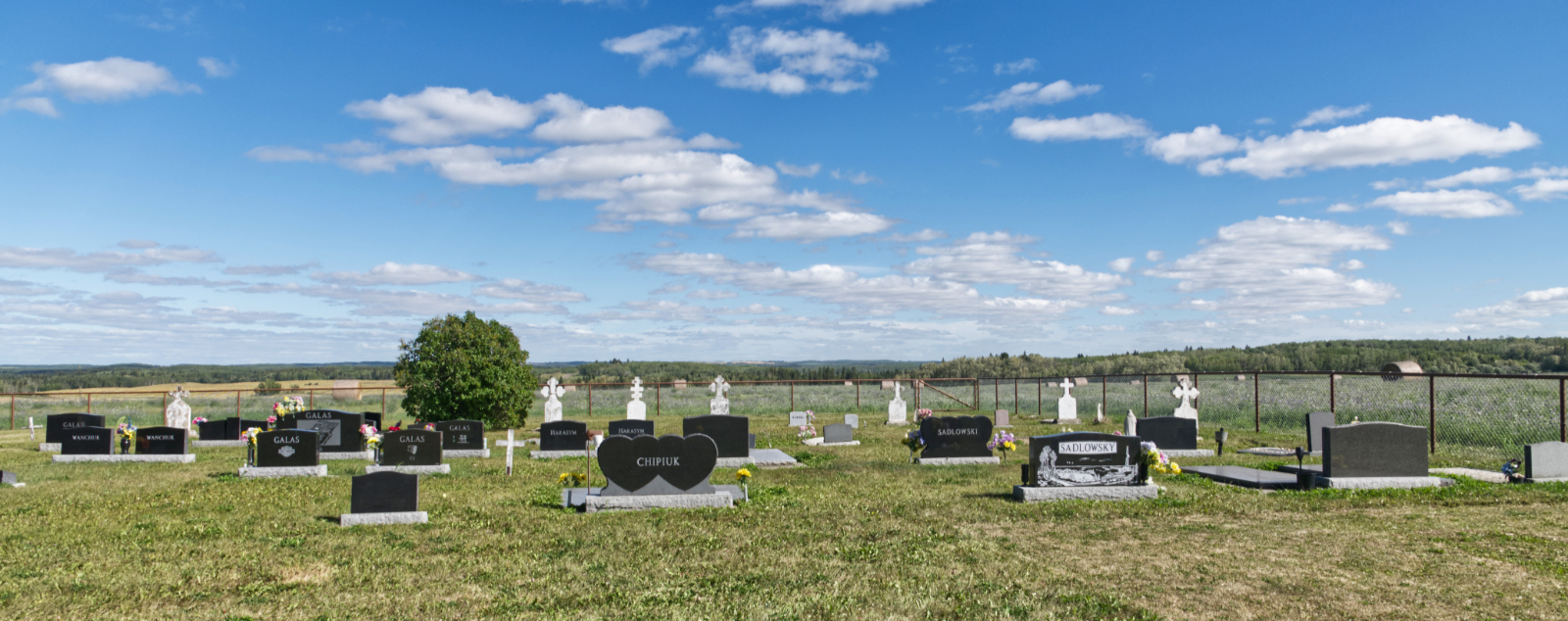

Play Memory Eternal Chant
GPS Co-ordinates: 54.238197, -111.677424
Affiliation: Ukrainian Orthodox Church of Canada



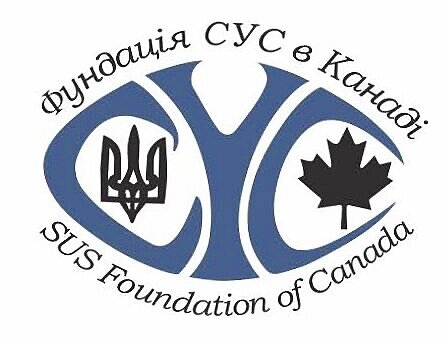 Financial support generously provided by:
Financial support generously provided by: 